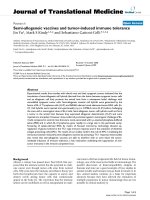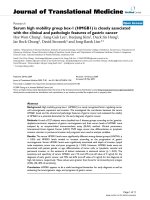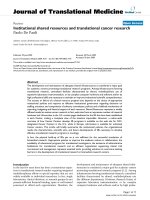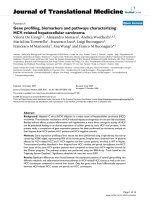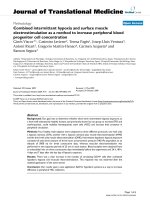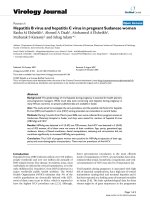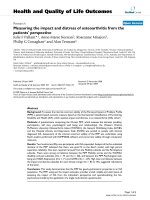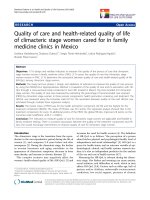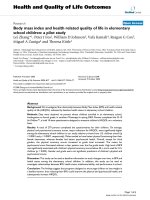báo cáo hóa học:" Serum heavy metals and hemoglobin related compounds in Saudi Arabia firefighters" pot
Bạn đang xem bản rút gọn của tài liệu. Xem và tải ngay bản đầy đủ của tài liệu tại đây (228.9 KB, 6 trang )
BioMed Central
Page 1 of 6
(page number not for citation purposes)
Journal of Occupational Medicine
and Toxicology
Open Access
Study protocol
Serum heavy metals and hemoglobin related compounds in Saudi
Arabia firefighters
Abdulrahman L Al-Malki
Address: Biochemistry Department, Faculty of Science, King Abdualziz University, Jeddah, Kingdom of Saudi Arabia
Email: Abdulrahman L Al-Malki -
Abstract
Background: Firefighters are frequently exposed to significant concentrations of hazardous
materials including heavy metals, aldehydes, hydrogen chloride, dichlorofluoromethane and some
particulates. Many of these materials have been implicated in the triggering of several diseases. The
aim of the present study is to investigate the effect of fire smoke exposure on serum heavy metals
and possible affection on iron functions compounds (total iron binding capacity, transferrin
saturation percent, ferritin, unsaturated iron-binding capacity blood hemoglobin and
carboxyhemoglobin,).
Subjects and methods: Two groups of male firefighter volunteers were included; the first
included 28 firefighters from Jeddah city, while the second included 21 firefighters from Yanbu city
with an overall age rang of 20–48 years. An additional group of 23 male non-firefighters volunteered
from both cities as normal control subjects. Blood samples were collected from all volunteer
subjects and investigated for relevant parameters.
Results: The results obtained showed that there were no statistically significant changes in the
levels of serum heavy metals in firefighters as compared to normal control subjects. Blood
carboxyhemoglobin and serum ferritin were statistically increased in Jeddah firefighters, (p < 0.05
and p < 0.05 respectively) and Yanbu firefighters, (p < 0.005 and p < 0.001 respectively) as
compared to normal control group while serum TIBC and UIBC were statistically decreased in
Yanbu firefighters as compared to Jeddah firefighters, (p < 0.005 and p < 0.005 respectively) and
normal control group, (p < 0.005 and p < 0.01 respectively). On the other hand, serum transferrin
saturation percent was elevated in only Yanbu firefighters, (p < 0.05) as compared to Jeddah
firefighters. Besides, there was no statistically significant change in blood hemoglobin and serum
iron on comparison between all studied groups.
Conclusion: Such results might point to the need for more health protective and prophylactic
measures to avoid such hazardous health effects (elevated Blood carboxyhemoglobin and serum
ferritin and decreased serum TIBC and UIBC) that might endanger firefighters working under
dangerous conditions. Firefighters must be under regular medical follow-up through standard
timetabled medical laboratory investigations to allow for early detection of any serum biochemical
or blood hematological changes.
Published: 7 July 2009
Journal of Occupational Medicine and Toxicology 2009, 4:18 doi:10.1186/1745-6673-4-18
Received: 27 July 2008
Accepted: 7 July 2009
This article is available from: />© 2009 Al-Malki; licensee BioMed Central Ltd.
This is an Open Access article distributed under the terms of the Creative Commons Attribution License ( />),
which permits unrestricted use, distribution, and reproduction in any medium, provided the original work is properly cited.
Journal of Occupational Medicine and Toxicology 2009, 4:18 />Page 2 of 6
(page number not for citation purposes)
Background
Fire Smoke is produced by either Combustion oxidation
or pyrolysis [1]. Smoke may also contain characteristic
trace and heavy elements such as lead, boron, cadmium,
selenium, arsenic, antimony and molybdenum [2].
Lead is a multitargeted toxicant, affecting the gastrointes-
tinal tract, hematopoietic, cardiovascular, central and
peripheral nervous systems, kidneys, immune, and repro-
ductive systems. As for arsenic, acute inhalation exposures
can damage mucous membranes, causing rhinitis, phar-
yngitis and laryngitis. Chronic inhalation exposures can
lead to rhino-pharyno-laryngitis, tracheobronchitis [3];
dermatitis, hyperpigmentation, and hyperkeratosis leuco-
penia, peripheral nerve dysfunction, [4] and peripheral
vascular disorders [5]. Toxicity resulting from chronic
exposure to mercury usually affects the kidneys and/or
nervous system. Inhalation exposure to cadmium may
result in headache, chest pains, muscular weakness, pul-
monary edema and death. Renal toxicity may also result
from inhalation exposure to cadmium, [6]. There is lim-
ited evidence from epidemiologic studies for cadmium-
related respiratory tract cancer. Long-term occupational
exposure to antimony has resulted in electrocardiac disor-
ders, respiratory disorders, and possibly increased mortal-
ity [7].
Carbon monoxide is a narcotic compound that is respon-
sible for up to 80 percent of fire related fatalities. Lethal
concentrations of carbon monoxide are generally attained
within l-3 hours of initiation of smouldering combustion.
Inhaled carbon monoxide combines with the hemo-
globin of red blood cells. The reaction of carbon monox-
ide with hemoglobin yields carboxyhemoglobin which is
inactive in oxygen transport since both gases react with
the same group in the hemoglobin molecule. The decrease
in oxygen transport capacity is proportional to the per-
centage of carboxyhemoglobin [8].
Measurements of serum iron and total iron binding capac-
ity are widely used in the diagnosis and treatment of iron
deficiency anemia and chronic inflammatory disorders
[9]. The clinical assessment of iron stores relied on the
determination of serum iron, total iron-binding capacity
and percent transferrin or direct examination of bone
marrow [10].
The first aim of the present study is to investigate if heavy
metals found in fire are transferred to the firefighters'
body, and secondly, the impact of fire smoke exposure on
serum iron and related compounds (Serum Iron, Total
Iron Binding Capacity, Transferrin saturation percent, Fer-
ritin, Unsaturated Iron-Binding Capacity Blood Hemo-
globin and Carboxyhemoglobin,)
Subjects and methods
The study protocol was approved by the local ethics com-
mittee. A written informed consent was obtained from all
subjects. Two groups of male non-smokers firefighters
volunteered to participate in the study: The first included
28 firefighters from Jeddah, mean age and standard devi-
ation (39 ± 6.5). The second included 21 firefighters from
Yanbu, mean age (43 ± 7.5). An additional group of 23
male non-firefighters volunteered from both cities as nor-
mal control subjects, mean age (41 ± 7.3). All subjects
were clinically investigated to exclude those who were suf-
fering from acute and/or chronic illnesses(as hyperten-
sion, diabetic, cardiac or occupational diseses). In
particular, normal chest x-ray was an essential exclusion
clinical parameter for the normal control group. All fire-
fighter volunteers were randomly chosen for participation
regardless of the type of burning materials and scale of fire
accidents they faced (household or industrial fire). An
official coordination was arranged with the Civil Defense
Administrations to obtain their consent to conduct the
research, and all participants were informed well about
the objective and the course of the study.
Ten milliliters of fasting venous blood were drawn from
each participant of the normal control group and the two
firefighters groups within the first hour of firefighting a
fire accident, regardless of time, scale, or type of the fire
accidents they faced; 5 ml of blood on lithium heparin for
iron and related compounds and 5 ml of blood without
anticoagulant for serum separation were also withdrawn.
Determination of Serum Heavy Metal
Serum samples were lysed for analysis of heavy metals by
adding 10 ml HNO
3
to one ml of serum and heated for 3–
4 hours, and then 1 ml perchloric was added to the same
sample. Digestion process continued until the solution
was clear. Atomic absorption spectrophotometry-flamless
method was used to determine serum Lead, Cadmium
and Antimony by using Shimadzu AA-6650G instrument
with electronic double-beam Graphite Furnace Atomic
Absorption, (GFAA) Spectrophotometer.
Atomic absorption spectrophotometry-Hydride Vapor
Generator method was used to determine serum arsenic
and serum mercury [10,11] by using Shimadzu AA-6650F.
Determination of Serum Iron and Some of its Biologically
Active Derivatives
Serum Iron, (Fe) was determined according to [12].
Serum Total Iron Binding Capacity, (TIBC) [13]. Serum
Transferrin saturation percent, (%TS) = (Serum Iron/
TIBCx100), [14]. Serum Ferritin [15]. Serum Unsaturated
Iron-Binding Capacity, (UIBC) = Total Iron Binding
Capacity (TIBC) – Serum Iron [16]. Blood Hemoglobin,
(HGB) [17]. Blood Carboxyhemoglobin, (COHb) [18].
Journal of Occupational Medicine and Toxicology 2009, 4:18 />Page 3 of 6
(page number not for citation purposes)
Statistical Analysis
Statistical analysis was performed on a PC using SPSS,
V.13. Data are presented as arithmetic mean ± S.D., with
subsequent use of Student t-test for the determination of
the significance of difference between sample means.
Results
There was no statistically significant difference in serum
heavy metals in Jeddah firefighters as compared to normal
control group, Yanbu firefighters as compared to normal
control group and Jeddah firefighters as compared to
Yanbu firefighters respectively (Table 1, Table 2 and Table
3). Results presented in tables (Table 4, Table 5 and Table
6) show that blood carboxyhemoglobin, (COHb) and
serum ferritin levels were statistically significantly ele-
vated in Jeddah firefighters, (p < 0.005 and p < 0.05
respectively) and Yanbu firefighters, (p < 0.005 and p <
0.001 respectively) as compared to normal control group.
On the other hand, serum total iron binding capacity,
(TIBC) and unbound iron binding capacity, (UIBC) were
statistically significantly elevated in Jeddah firefighters, (p
< 0.005 and p < 0.005) and normal control group, (p <
0.005 and p < 0.01 respectively) as compared to Yanbu
firefighters. However, serum transferrin saturation percent
was statistically significantly decreased in Jeddah firefight-
ers as compared to Yanbu firefighters, (p < 0.05) as shown
in table 6. Statistical comparison between Jeddah and
Yanbu firefighters showed that there were significant dif-
ferences in TIBC, transferring and UIB.
Discussion
Most important of all are the poisonous effects of heavy
metals. Firefighters are the subjects most exposed to toxi-
cants that may have adverse effect on their life. Two
groups of firefighters from Jeddah and Yanbu cities and
one control group were included in this study.
Results presented in tables (1 &2 &3) showed that there
were no statistically significant changes in the levels of
serum heavy metals between firefighters and control
group. This is in accordance with the study of [19], which
stated that mercury levels were not higher in exposed fire-
fighters but are mentioned because of heightened concern
about exposure at the World Trade Center. One control
and three exposed firefighters had total blood mercury
levels > 20 μg/l, a conservative upper reference limit.
Because blood inorganic mercury was < 1.7 μg/l for all
exposed firefighters, these elevated total blood mercury
concentrations represent organic mercury contributions
from dietary sources, (e.g., fish consumption) rather than
from exposure.
The urinary antimony-adjusted geometric mean of the
Special Operations Command group was two times
higher than that of the other exposed firefighters or con-
trols [20]. Two populations (firefighters and the general
population) were surveyed in four cities for urine heavy
metal concentrations. Arsenic and cadmium levels were
significantly related to smoke exposure, and for firefight-
ers, arsenic levels were significantly related to exposure
[21].
Measurements of serum iron and total iron binding capac-
ity are widely used in the diagnosis and treatment of iron
deficiency anemia and chronic inflammatory disorders
[22]. Historically the clinical assessment of iron stores has
relied on the determination of serum iron, total iron-
binding capacity and percent transferrin or direct exami-
nation of bone marrow. The literature suggests that ferri-
tin provides a more sensitive, specific and reliable
measurement for determining iron deficiency at an early
stage [23].
Results of statistical analysis of serum iron and its related
reactive derivatives in table (4) showed that blood carbox-
yhemoglobin and serum ferritin were statistically
increased in Jeddah firefighters, (p < 0.05 for each) and
Yanbu firefighters, (p < 0.005 and p < 0.001 respectively)
as compared to normal control group while serum TIBC
and serum UIBC were statistically decreased in Yanbu fire-
Table 1: Statistical Analysis of Serum Heavy Metals in Jeddah Firefighters as Compared to the Normal Control Group, (mean ± S.D.).
Parameter Normal Control Group n Jeddah FFs* n t-test p- value
Lead (μg/dL) 3.73 ± 1.21 8 3.49 ± 1.06 8 0.4208 N.S.
Arsenic (μg/dL) 0.36 ± 0.12 8 0.34 ± 0.23 8 0.1898 N.S.
Mercury (μg/dL) 0.27 ± 0.04 8 0.27 ± 0.05 8 0.1520 N.S.
Cadmium (μg/dL) 0.08 ± 0.06 8 0.07 ± 0.03 8 0.2444 N.S.
Antimony (μg/dL) 0.00 ± 0.00 8 0.00 ± 0.00 8 N.S.
*FFs: firefighters
N.S: non-significant
Journal of Occupational Medicine and Toxicology 2009, 4:18 />Page 4 of 6
(page number not for citation purposes)
Table 2: Statistical Analysis of Serum Heavy Metals in Yanbu Firefighters as Compared to the Normal Control Group, (mean ± S.D.).
Parameter Normal Control Group n Yanbu FFs* n t-test p- value
Lead (μg/dL) 3.73 ± 1.21 8 3.83 ± 1.64 16 0.14453 N.S.
Arsenic (μg/dL) 0.36 ± 0.12 8 0.33 ± 0.15 18 0.4464 N.S.
Mercury (μg/dL) 0.27 ± 0.04 8 0.28 ± 0.05 19 0.5200 N.S.
Cadmium (μg/dL) 0.08 ± 0.06 8 0.10 ± 0.08 18 0.7711 N.S.
Antimony (μg/dL) 0.00 ± 0.00 8 0.00 ± 0.00 18 N.S.
*FFs: firefighters
N.S: non-significant
Table 3: Statistical Analysis of Serum Heavy Metals in Yanbu Firefighters as Compared to Jeddah Firefighters, (mean ± S.D.).
Parameter Jeddah FFs* n Yanbu FFs* n t-test p- value
Lead (μg/dL) 3.49 ± 1.06 8 3.83 ± 1.64 16 0.52231 N.S.
Arsenic (μg/dL) 0.34 ± 0.23 8 0.33 ± 0.15 18 0.1267 N.S.
Mercury (μg/dL) 0.27 ± 0.05 8 0.28 ± 0.05 19 0.3283 N.S.
Cadmium (μg/dL) 0.07 ± 0.03 8 0.10 ± 0.08 18 1.0303 N.S.
Antimony (μg/dL) 0.00 ± 0.00 8 0.00 ± 0.00 18 N.S.
*FFs: firefighters
N.S: non-significant
Table 4: Statistical Analysis of Serum Iron and Some of its Biologically Active Derivatives in Jeddah Firefighters as Compared to the
Normal Control Group, (mean ± S.D.).
Parameter Normal Control Group n Jeddah FFs* n t-test p- value
HGB (g/dl) 15.52 ± 1.51 23 16.26 ± 1.12 27 1.9801 N.S.
COHb (%) 3.000 ± 1.27 17 5.43 ± 2.91 22 3.20993 p < 0.005
Iron (ug/dl) 86.43 ± 25.76 21 80.0 ± 28.84 28 0.821094 N.S.
TIBC (ug/dl) 324.36 ± 33.99 22 330.48 ± 50.77 27 0.4833 N.S.
Transferrin sat. (%) 26.31 ± 9.83 22 24.06 ± 9.40 27 0.8175 N.S.
Ferritin (ng/ml) 78.19 ± 34.09 20 123.26 ± 63.10 27 2.89175 p < 0.05
UIBC (ug/dl) 240.64 ± 49.45 22 253.30 ± 61.27 27 0.7830 N.S.
*FFs: firefighters
N.S: non-significant
Journal of Occupational Medicine and Toxicology 2009, 4:18 />Page 5 of 6
(page number not for citation purposes)
fighters as compared to Jeddah firefighters, (p < 0.005 for
each) and normal control group, (p < 0.005 and p < 0.01
respectively). On the other hand, serum transferrin satura-
tion percent was elevated in only Yanbu firefighters, (p <
0.05) as compared the Jeddah firefighters, there was no
statistically significant change in blood hemoglobin and
serum iron comparing all studies group.
Exposure to carbon monoxide is determined by the meas-
urement of the percent carboxyhemoglobin, (%COHb).
The brain and the heart may be severely affected after CO
exposure with carboxyhemoglobin, (COHb) levels
exceeding 20%, [24], although earlier studies in coal mine
fires indicated that very few victims had 60% COHb at
death, almost all having ≥ 80 COHb. Fire victims could
have less and sometimes much less than 50% COHb, yet
their death can be clearly attributed to smoke inhalation
from other evidence obtained at autopsy and other inves-
tigations [25].
Levy [26] stated that, a statistically significant difference
was found between the mean baseline carboxyhemo-
globin of non-smoking firemen and smoking firemen. A
consistent increase in mean COHb levels after exposure to
smoke was seen in both non-smoking and smoking men,
but the mean increase in these two groups was statistically
significant only at the 90 percent level, (t = 1.85, p < 0.1).
This is in accordance with our results obtained in table
(4). Kales [27] conducted an investigation of unexpect-
Table 5: Statistical Analysis of Serum Iron and Some of its Biologically Active Derivatives in Yanbu Firefighters as Compared to the
Normal Control Group, (mean ± S.D.).
Parameter Normal Control Group n Yanbu FFs* n t-test p- value
HGB (g/dl) 15.52 ± 1.51 23 15.66 ± 1.55 21 0.3040 N.S.
COHb (%) 3.000 ± 1.27 17 4.93 ± 2.37 21 3.01979 p < 0.005
Iron (ug/dl) 86.43 ± 25.76 21 87.52 ± 27.15 21 0.1341 N.S.
TIBC (ug/dl) 324.36 ± 33.99 22 283.38 ± 50.34 21 3.1421 p < 0.005
Transferrin sat. (%) 26.31 ± 9.83 22 31.31 ± 9.57 21 1.6908 N.S.
Ferritin (ng/ml) 78.19 ± 34.09 20 169.55 ± 103.22 14 3.70087 p < 0.001
UIBC (ug/dl) 240.64 ± 49.45 22 195.91 ± 50.76 21 2.9270 p < 0.01
*FFs: firefighters
N.S: non-significant
Table 6: Statistical Analysis of Serum Iron and Some of its Biologically Active Derivatives in Yanbu Firefighters as Compared to Jeddah
Firefighters, (mean ± S.D.).
Parameter Jeddah FFs* n Yanbu FFs* n t-test p- value
HGB (g/dl) 16.26 ± 1.12 27 15.66 ± 1.55 21 1.5493 N.S.
COHb (%) 5.43 ± 2.91 22 4.93 ± 2.37 21 0.6138 N.S.
Iron (ug/dl) 80.00 ± 28.84 28 87.52 ± 27.15 21 0.9396 N.S.
TIBC (ug/dl) 330.48 ± 50.77 27 283.38 ± 50.34 21 3.2003 p < 0.005
Transferrin sat. (%) 24.06 ± 9.40 27 31.31 ± 9.57 21 2.6333 p < 0.05
Ferritin (ng/ml) 123.26 ± 63.10 27 169.55 ± 103.22 14 1.78416 N.S.
UIBC (ug/dl) 253.30 ± 61.27 27 195.91 ± 50.76 21 3.4641 p < 0.005
*FFs: firefighters
N.S: non-significant
Publish with BioMed Central and every
scientist can read your work free of charge
"BioMed Central will be the most significant development for
disseminating the results of biomedical research in our lifetime."
Sir Paul Nurse, Cancer Research UK
Your research papers will be:
available free of charge to the entire biomedical community
peer reviewed and published immediately upon acceptance
cited in PubMed and archived on PubMed Central
yours — you keep the copyright
Submit your manuscript here:
/>BioMedcentral
Journal of Occupational Medicine and Toxicology 2009, 4:18 />Page 6 of 6
(page number not for citation purposes)
edly high level carboxyhemoglobin in a group of firefight-
ers. Twelve of 34, (35%) nonsmokers tested had levels
greater than 4% COHb and 9 of 34, (26%) had levels of
10% or higher. All 24 nonsmoking firefighters retested
had COHb levels less than 3%. Baseline carboxyhemo-
globin readings of 64 firefighters ranged from 0% to 3%
(mean 1% and median 1%). One hundred eighty-four
carboxyhemoglobin readings were collected during train-
ing exercises. The mean and median carboxyhemoglobin
levels were 1%. The maximum value in a firefighter wear-
ing self-contained breathing apparatus was 3%; values of
14%, 5%, and 4% were measured in instructors who were
not properly wearing self-contained breathing apparatus
[28-30].
Conclusion
Such results might point to the need for more health pro-
tective and prophylactic measures in order to avoid such
hazardous health effects that might endanger firefighters
working under highly dangerous conditions. Firefighters
must be under regular medical follow-up through stand-
ard timetabled medical laboratory investigations to allow
for early detection of any hematological changes.
Competing interests
The author declares that they have no competing interests.
References
1. Cones MC, Radomski MW, Vanhelder JWP, Rhind SG, Shephard RJ:
Endurance exercise with and without a thermal clamp:
effects on leukocytes and leukocyte subsets. J Appl Physiol.
1996, 81(2):822-829.
2. Bates HM: How to Detect Iron Deficiency Before Anemia
Develops. Laboratory Pathfinder 1980, 1:17-22.
3. Beton RW, Franklin MR, Hildebrandt AG: Factors influencing the
inhibitory effect of carbon monoxide on cytochrome P-450-
catalyzed mixed function oxidation reactions. Annals of the
New York Academy of Sciences 1996, 174(1):218-232.
4. Brehner kiten CH, Pinto SS, Nelson KW: Medical problems asso-
ciated with arsenic exposure. J Occup Med 2003, 19(6):391-396.
5. Blom S, Lagerkvist B, Linderholm H: Arsenic exposure to smelter
workers: clinical and neurophysiological studies. Scand J Work
Environ Health 1985, 11:265-270.
6. Edelman P, Osterloh J, POirkle J, Pirkle J, Caudill SP, Grainger J, Jones
R, Blount B, Calafat A, Turner W, Feldman D, Baron S, Baron S, Ber-
nard B, Lushniak BD, Kelly K, Prezant D: Biomonitoring of chem-
ical exposure among New York City firefighters responding
to the World Trade Center fire and collapse. Environ Health
Perspect 2003, 111(16):1906-1911.
7. Ernst VF, Zibrak GG: Biochemical aspects of hematology. In
Tietz Textbook of Clinical Chemistry 3rd edition. Edited by: Burtis CA,
Ashwood ER. Philadelphia: W.B. Saunders; 1998:1642-1710.
8. Fairbanks VF, Klee GG: Biochemical aspects of hematology. In
Tietz Textbook of Clinical Chemistry 3rd edition. Edited by: Burtis CA,
Ashwood ER. Philadelphia: W.B. Saunders; 1999:1642-1710.
9. Goyer R: Toxic effects of metals. In Casarett and Doull's Toxicology
4th edition. Edited by: Amdur MO, Doull JD, Klaassen CD. New York:
Pergamon Press; 1991:623-680.
10. Miller DT, Paschal DC, Gunter EW, Stroud PE, D'Angelo J: Deter-
mination of lead in blood using electrothermal atomisation
atomic absorption spectrometry with a L'vov platform and
matrix modifier. Analyst 1987, 112(12):1701-1704.
11. Ohlemiller TJ: Smouldering combustion. In The SFPE Handbook of
Fire Protection Engineering Volume Chapter l-23
. Edited by: Dinenno PJ.
Quincy, MA: National Fire Protection Association; 1988:352-359.
12. Olson J, Ishikawa F, Rowan M, Sallinen J: Performance of the Anemia
Panel Assays, (Ferritin, Folate and Vitamin B12) on the Abbott AxSYM®
Instrument Chicago, Illinois: American Association for Clinical Chem-
istry Annual Meeting; 2006.
13. Pegon Y: Direct determination of arsenic in blood serum by
electrothermal atomic absorption spectrometry. Analytica
Chimica Acta 1985, 172:147-156.
14. Pieracci FM, Barie PS: Diagnosis and management of iron-
related anemias in critical illness. Crit Care Med 2006,
34:1898-1905.
15. Renes LE: Antimony poisoning in industry. Arch Ind Hyg 1993,
7:99-108.
16. Saikia : Behavior of B, Cr, Se, As, Pb, Cd and Mo present in
waste leachates generated from combustion residues during
the formation of ettringite. Environmental toxicology and chemistry
2006, 25(7):1710-1719.
17. Smith RP: Toxic responses of the blood. In Casarett and Doull's
Toxicology: The Basic Science of Poisons Volume Chapter 8. 3rd edition.
Edited by: Klaassen CD, Amdur MO, Doull J. New York: Macmillan
Publishing Company; 1984:228-231.
18. Tietz NW, Rinker AD, Morrison SR: When is a serum iron really
a serum iron? The status of serum iron measurements. Clin-
ical Chemistry 1994, 40:546-551.
19. Them K: Mortality among a cohort of U.S. cadmium produc-
tion workers – an update. J Natl Cancer Inst 1985, 74(2):325-333.
20. Hartzell GE: Intoxication of Rats by Carbon Monoxide in the
Presence of an Irritant. J Fire Sciences 1996, 3:263-279.
21. Hine CH, Pinto SS, Nelson KW: Medical problems associated
with arsenic exposure. J Occup Med 1977, 19(6):391-396.
22. Henry JB: Clinical Diagnosis and Management by Laboratory Methods
18th edition. Philadelphia: W.B. Saunders; 1984:204-211.
23. Heeney MM, Andrews NC: Iron homeostasis and inherited iron
overload disorders: an overview. Hematol Oncol Clin North Am
2004, 18:
1379-1403.
24. Lagerkvist BEA, Linderholm H, Nordberg GF: Vasospastic ten-
dency and Raynaud's phenomenon in smelter workers
exposed to arsenic. Environ Res 1986, 39:465-474.
25. Lundgren KD: Damage in the respiratory organs of workers at
a smeltery. Nord Hyg Tidskr 1994, 3:66-82.
26. Levey JB: Clinical Diagnosis and Management by Laboratory Methods 18th
edition. Philadelphia: W.B. Saunders; 1996:204-211.
27. Kales RJ, Sobel C, Berkman S: Interferences with biuret methods
for serum proteins. Anal Chem 2003, 29:1491-1495.
28. Wick M, Pingerra W, Lehmann P: Clinical aspects and laboratory. Iron
metabolism, anemias 5th edition. Wien, New York: Springer; 2003.
29. Wians M: Discriminating Between Iron Deficiency Anemia
and Anemia of Chronic Disease Using Traditional Indices of
Iron Status vs Transferrin Receptor Concentration. Am J Clin
Pathol 2001, 115(1):112-118.
30. Wolfe RD: Ferritin and Transferrin in Iron Deficiency and
Overload. Immunodiagnostics 2004, XII(1):.
